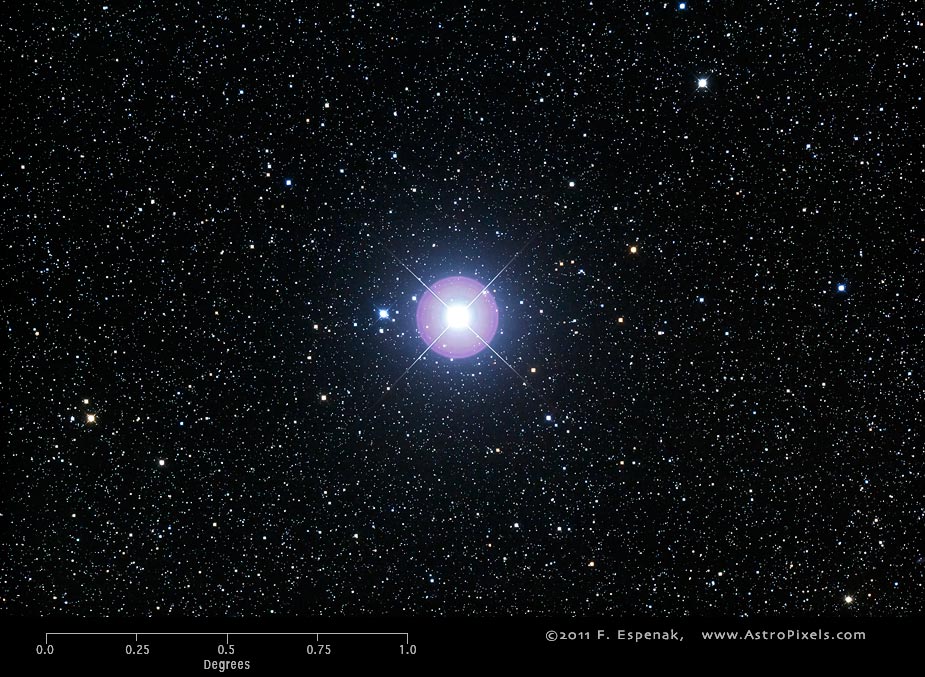Procyon
Procyon or Alpha Canis Minoris (Alp CMi) is the brightest naked eye star in the constellation Canis Minor. With an apparent magnitude of 0.4, Procyon is the 8th brightest star in the entire sky (see: 50 Brightest Stars ). Its absolute magnitude is 2.68 and its distance is 11.4 light years.The Equinox J2000 equatorial coordinates are RA = 07h 39m 18.1s, Dec = +05° 13' 30".
Procyon has a spectral type of F5IV, a surface temperature of 6650° Kelvin and a luminosity 6.9 times the Sun. It has a mass of 1.4 solar masses and a diameter 2 times the Sun.
The image above shows the uncropped view of Procyon (North is up) through the Takahashi E-180 Astrograph.
To the naked eye, Procyon appears to be a single star. However, it is actually a binary star system, consisting of a white main sequence star (spectral type F5 IV-V) named Procyon A, and a faint white dwarf companion (spectral type DA) named Procyon B. Procyon is bright not because of its intrinsic luminosity but because of its close proximity to the Sun; at a distance of 11.46 light years (3.51 parsecs), it is one of our near neighbours.
The surface temperature of Procyon A is an estimated 6,530 Kelvin, giving it a white hue. It is 1.4 times the mass, twice the radius, and 6.9 times more luminous than the Sun. Procyon A is bright for its spectral class, suggesting that it is a subgiant that has nearly fused its core hydrogen into helium. It will eventually expand as "burning" moves outside the core and the star swells 80 to 150 times its current diameter. This should happen within 10 to 100 million years.
Like Sirius B, Procyon's companion is a white dwarf that was inferred from astrometric data long before it was observed. Its existence was first postulated by Friedrich Bessel (1844). Although its orbital elements had been calculated by Arthur Auwers in 1862, Procyon B was not visually confirmed until 1896 when John Martin Schaeberle observed it at the predicted position using the 36-inch refractor at Lick Observatory. It is more difficult to observe from Earth than Sirius B, due to a greater apparent magnitude difference and smaller angular separation from its primary. The average separation of the two components is 15.0 AUs, a little less than the distance between Uranus and the Sun, though the eccentric orbit carries them as close as 8.9 AUs and as far as 21.0 AUs.
At 0.6 solar masses, Procyon B is considerably less massive than Sirius B; however, the peculiarities of degenerate matter ensure that it is larger than its more famous neighbor, with an estimated radius of 8,600 km, versus 5,800 km for Sirius B. With a surface temperature of 7,740 Kelvin, it is also much cooler than Sirius B; this a testament to its lesser mass and greater age. The mass of the progenitor star for Procyon B was about 2.5 solar masses and it came to the end of its life some 1.7 billion years ago, after a main sequence lifetime of 400-600 million years. For this reason, the age of Procyon A is expected to be at least 2 billion years.
Procyon forms one of the three vertices of the Winter Triangle, along with Sirius and Betelgeuse.
The description above is based on the Procyon entry in Wikipedia.For more information about Procyon, see Stars (Jim Kaler).
Technical Details
- Object: Procyon
- Other Names: Alpha Canis Minoris, HR2943, HD61421, HIP37279
- Object Type: bright star
- Object Data: Apparent Magnitude = 0.4, Absolute Magnitude = 2.68, distance = 11.4 light years
- Object Position (Equinox J2000): RA = 07h 39m 18.1s, Dec = +05° 13' 30", Constellation = Canis Minor
- Date/Time: 2011 Apr 02 at 04:35:57 UTC
- Location: Bifrost Astronomical Observatory, Portal, AZ
- Mount: Astro-Physics 1200GTO
- Telescope: Takahashi Epsilon 180 Hyperbolic Astrograph
- Camera: Canon EOS 550D (Rebel T2i) (modified with a Baader UV/IR filter)
- Field of View: 1.70° x 2.56° at 1.7 arc-sec/pixel (web version: 10.0 arc-sec/pixel)
- Exposure: 2 x 300s, f/2.8, ISO 800
- File Name: Procyon-01w.jpg
- Processing (Adobe Camera Raw): Graduated Filter, Vignetting Correction, Noise Reduction, White Balance, Curves
- Processing (Photoshop CS5): Average Images, Curves, Noise Reduction
- Original Image Size: 3454 × 5179 pixels (17.9 MP); 11.5" x 17.3" @ 300 dpi
- Rights: Copyright 2011 by Fred Espenak. All Rights Reserved. See: Image Licensing.
